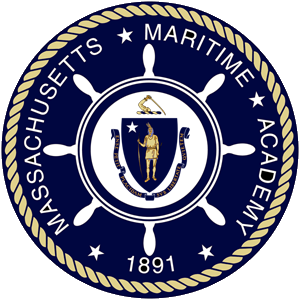MT-2371
Sea Term II - Deck
Course Description
Provides an opportunity for cadets to obtain sea service as an officer in charge of a navigational watch in a structured shipboard training program. The training uses a building block approach, bringing the cadet up to an acceptable level of proficiency in each area of required competence. Shipboard training is closely integrated with the shore-based academic curriculum at the Academy. The Sophomore Sea Term focuses upon all facets of shipboard operations and provides cadets an opportunity to practice terrestrial navigation skills.
This course consists of an approximately 52-day long shipboard experence on the training vessel including watchstanding, maintenance and training.
Learning Objectives
Demonstrate knowledge and understanding of the following STCW elements:
- RFPNW-X1.3 Change-over from automatic pilot to hand steering and vice versa
- OICNW-A1.08 Knowledge of steering control systems
- OICNW-A1.08 Steering system operational procedures
- OICNW-A1.08 Steering system change-over from manual to automatic control and vice versa
- OICNW-A1.08 Adjustment of steering system controls for optimum performance
Topics
- Training
- Celestial Navigation
- Marine Sextant Intro
- Sunline/Azimuth, Rising/Setting, LAN, Star Sights
- Quartermaster Communications
- VHF Radio Telephone
- GMDSS Workstation
- Quartermaster Lobbooks
- Logbook Review and Procedures
- Bell Book Entries
- Electronic Navigation
- Automatic Identification Systems(AIS)
- Satellite Navigation Systems (GPS)
- ECDIS
- Firefighting
- Fire Theory & Shipboard Detection
- Firefighting Equipment - Primary, Fixed, Portable
- Firefighting - On scene
- Breathing Apparatus-Scott Air Pack
- Naval Architecture
- Ship's Construction
- Navigation
- Magnetic Compass and Compass Adjustment
- Gyro Compass
- Chart & Pub Corrections
- Steering Systems
- Steering Systems - Controls, Change-Over, Autohelm
- After Steering System
- Marine Weather
- Weather Observation I & II
- Voyage Planning
- Voyage Planning Project
- Piloting
- Terrestrial Lines of Position
- Advanced Piloting Evolution
- RADAR
- RADAR Watch Standing, Plotting, Navigation
- Rigging
- Boatswain's Chair, Staging
- Rigging Basics
- Rigging Exercises
- Shipboard Safety
- Hand Tools
- Safety Procedures Aboard TS Kennedy
- Safety Management Systems
- Seamanship
- Marlinspike: Knots
- Marlinspike: Splicing Fiber Rope
- Mooring Lines
- Splicing Braided Line
- Block & Tackle
- Confined Space
- Atmosphere Testing
- Watchstanding
- Bridge Command and Control Systems
- Bridge Introduction
- Collision Avoidance
- Celestial Navigation
- Watchkeeping
- Assistant Navigator
- Fixing Vessel Position
- Computing Compass Error
- Determine SMG & SMG
- Effective Communication
- Quartermaster
- Proper Use of PA, Sound-Powered Telephone, & Ship's Alrm Systems
- Updating Course Board
- Making Proper Logbook Entries
- Use of EOT & Bell Book Entries
- Helmsman
- Proper Relief
- Accurate Steering
- Use and Understanding of Commands
- Weather observer
- True Wind Direction & Speed
- Cloud Observation
- Sea State Estimation
- Transmission of NOAA VOS Reports
- RADAR Observer
- Maintain Vigilant Watch
- Identify Contacts
- Effective Communication
- Assistant Navigator
- Maintenance
- Work on Deck with Chief Mate & Bosun
- Coating Upkeep
- Shipboard Equipment Upkeep
- Work on Deck with Chief Mate & Bosun
Other objectives
- Proficiencies OICNW‑1‑3B Chart selection and OICNW‑1‑3C Route planning may be completed on this sea term, but must be completed by the end of Sea Term IV.
